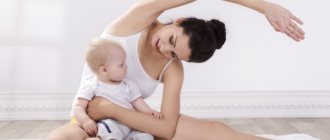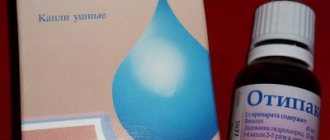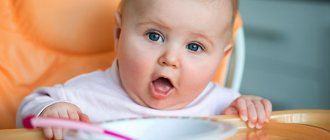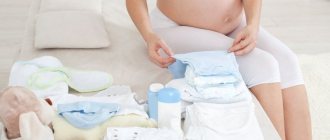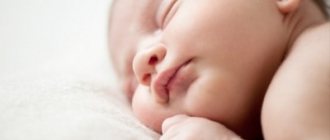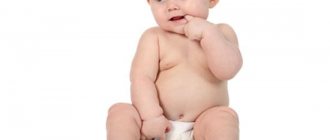Finally, the long-awaited day for the whole family has arrived, and the mother and her newborn baby are being discharged home from the maternity hospital. All the worst and most difficult things are behind us, an equipped room and all the relatives are waiting at home. But the young mother still has a lot of troubles ahead; she needs to adapt to the baby and learn how to care for him.
Of course, the most pleasant procedure in care after discharge will be bathing the baby, but you need to approach the baby’s first bath very seriously and responsibly. Water treatments have a beneficial effect on the baby's health .
The benefits of water procedures
Proper organization and conduct of bathing will allow the baby to actively develop and be healthy. No one doubts the benefits of swimming and water procedures anymore, as they:
- maintain skin parameters;
- promote better blood circulation;
- relaxes muscles and relieves tone;
- eliminate intestinal colic;
- harden the body;
- help prevent skin diseases and allergies;
- activate the child’s physical activity;
- promote sound sleep and good appetite.
The first bath in the life of a newborn baby is also very important psychologically. Children are bathed not only in order to cleanse the skin, but also so that the child can actively swim, splash in the water and explore the world during water procedures. The baby should receive only positive emotions from the process. So, you need to be well prepared for your baby’s first bath. It is best to stock up on the necessary things before entering the maternity hospital. Mom can do this while still pregnant.
Pediatricians have different opinions regarding the frequency of bathing. Some mothers say that the bathing procedure should occur every day, others say that frequent washing dries out the skin and therefore you should not abuse the procedure and wash your baby several times a week.
This will be decided by the child’s parents, because bathing should bring joy and pleasure not only to the baby, but also to his parents. As a rule, children love to swim and sleep well after a bath, so many mothers bathe their babies every day before bed. This is not so much bathing in terms of washing, but intense physical activity.
Preparing to bathe your newborn for the first time
How to bathe a baby for the first time? First you should prepare everything you need. What you will need:
- Baby bath;
- Slide, neck circle or hammock;
- Thermometer;
- Diaper or terry towel;
- Children's bathing cosmetics.
If necessary, you can prepare herbal decoctions and add them to the bath. Chamomile and lavender work well. They calm the child's psyche and take care of the baby's skin. The use of washcloths is not necessary, but you can stock up on special ones for children; they are very soft, fabric or sponge.
What else do you need to know:
- To rinse your baby from soapy water, it is better to stock up on a ladle with warm, clean water;
- You don’t have to buy a special baby towel with a hood for drying. A regular adult will do. The main thing is that it is clean, soft and absorbs moisture well;
- The necessary cosmetics and products for the baby are prepared in advance on the changing table. After a bath, children's skin can be smeared with cream and special oil. Sunflower will do, the main thing is to sterilize it first;
- You should also take care of materials for treating the umbilical wound. You need cotton wool, hydrogen peroxide, brilliant green;
- The final element is a diaper, a clean diaper and clothes.
Necessary items for swimming
In order for all family members to receive positive emotions from their baby’s first bath and in the future, daily water procedures take place only with a smile, you need to prepare for this in advance and buy some things:
- Bath. They can be very diverse: the simplest and anatomical, repeating the curves of the child’s body, small and huge in size. Parents choose. It all depends on the financial situation of a particular family.
- Washcloth. It is best to use a piece of soft cloth for this.
- Water thermometer. It is imperative to control the temperature of the water in which the child bathes.
- Ladle for pouring. At the end of the procedure, it is recommended to pour settled water over the baby.
- Towel. It should be cotton and very soft.
- Sleepwear.
- Children's cosmetics. It should be as natural as possible so as not to cause allergies in the child.
Newborn's first bath at home
All children love to swim. The exception is that small group of babies who, in infancy, were scared during their first immersion in water. This fear will leave an indelible, unpleasant mark on their memory for a long time. It will be difficult for them to overcome and forget their fear of water. Therefore, it is very important that this procedure brings pleasure to the baby. Parents need to know when, under what conditions and with what means they can bathe their newborn.
When to bathe your baby for the first time
Several factors will be decisive in choosing the timing of the first water procedure. It is not recommended to bathe immediately after discharge if:
- the newborn was vaccinated with BCG (for tuberculosis) the day before, and it did not dry out;
- the baby's clothespin on the navel has not yet fallen off;
- The baby is naughty or just tired.
Bathing water
Water quality is one of the most important conditions . The child’s health depends on it; the newly healed navel and the baby’s very delicate skin will come into contact with it.
- Be sure to boil water for bathing.
- If your baby has a heat rash or allergic dermatitis, your doctor may recommend bathing in a herbal decoction.
- The water should not be bitter. It is best not more than 37 degrees; later you can gradually lower the temperature for the purpose of hardening.
Important Details
How to properly hold your baby during bath procedures? The mother lowers the baby into the bath with both hands, while her left hand supports the head. Dip the baby into the water up to its shoulders. You need to hold the head on your left forearm, and hold the baby’s back with your fingers.
This is the safest way of bathing: the baby reclines in the bath, leaning securely on his mother's hand.
- When bathing, take care to thoroughly rinse all the folds on the baby’s body: dust accumulates there.
- If crusts have formed on the baby's head, they should be lubricated with oil before bathing and the head should be washed with baby shampoo. All movements are from the forehead to the back of the head.
- How to wash a girl's genitals? The perineum is washed towards the butt to avoid introducing infection into the vagina.
- How to properly wash a newborn boy? To prevent inflammation of the skin of the genitals, you need to pull back the foreskin a little and wash the genitals with your hand.
- The first bath lasts no more than three minutes, then the procedure can be gradually increased to ten minutes. However, it is not recommended to keep it in water for more than ten minutes.
- How often should you bathe your baby? In the first six months - every day, in the second six months - every other day.
- How often should you wash your baby? After each bowel movement. In this case, the baby should be held under the tap with the right hand, and the butt and genitals should be washed with the left.
- How to properly bathe a newborn boy? Just like the girl.
- How to wash a newborn boy after bowel movement? Hold under the tap with your right hand and wash with your left.
- How often should you wash your baby with soap? Pediatricians recommend baths with soap no more than twice a week. Soap breaks the surface protective layer of the baby's skin, so wash it with soap not often.
- To prevent your baby from freezing when bathing, wet the parts of the body that are not covered with water regularly.
Step-by-step instructions for bathing a baby
After two days at home, you can bathe your baby. Why on the second? In order not to expose the baby to unnecessary stress, since he may already be nervous due to a change in environment.
Everything must be prepared in advance, since the child must not be left alone in the bath. It is best to postpone the bathing procedure to the evening before bedtime. The child should not be completely hungry, otherwise bathing will not bring him any joy. He will cry and ask for food.
The air temperature in the room should be from +22 to +23 degrees . The door to the room must be open to avoid a significant increase in air humidity.
So let's get started:
- Lubricate seborrheic crusts with sunflower oil, if any. We do this twenty minutes before bathing so that they are thoroughly soaked.
- Before bathing, we undress the baby and leave him to take air baths, while you can play with him and massage him with stroking movements.
- Fill the bath with boiled water and bring it to the required temperature.
- To prevent the baby from being afraid of new sensations, it is best to immerse him in water wrapped in a diaper, and as soon as the baby gets used to it, pull the diaper out of the water.
- We lower the baby into the water gradually and very slowly so as not to scare him.
- With one hand you need to hold the baby’s neck and head, with the thumb touching the baby’s left shoulder, and the remaining fingers holding the baby under the armpit on the left side. This position is comfortable and stable for the child, and the adult thus holds the baby very tightly and will not drop him.
- With your free right hand we pour water on the baby.
- We wash the baby's face with water without soap, while carefully rinsing the eyes.
- We wash all the folds on the child’s body using soap.
- Wash your hair thoroughly with soap.
- Girls are washed with a movement from the pubis to the butt, for boys everything is much simpler, they simply wash their genitals.
- It is not recommended to continue the first bath for more than five minutes.
- After bathing, we take the baby out of the bath and pour clean water over it, at a temperature 2 degrees higher than the one in which the baby bathed.
- We wrap the child in a towel and wipe it very carefully, using blotting movements.
- We treat all folds on the child’s body with baby cream.
If you follow all the rules, then bathing will be a pleasure for all members of the family . But there are times when things don't go as planned. But it is better to be prepared for unforeseen situations in order to be able to react correctly.
How to bathe a newborn for the first time at home
After preparing the water and aids, the baby is undressed and allowed to spend some time in the air to take air baths. They will serve as excellent hardening. You should not wash your baby in the bathtub after defecation. Before bathing, wash it or wipe it with a damp cloth. The first few baths of a newborn should be carried out in a thin, clean diaper. It will protect the delicate body from sudden contact with water and allow it to adapt to the new environment. The baby is slowly immersed in the water, using the palm of the hand to wet the diaper from the legs to the shoulders. Mommy can talk to him, hum a song, acting firmly and carefully.
The head and neck are held with a bent arm. In this case, the thumb is located above the baby’s shoulder, and the rest hold the armpit. There are special slides-beds that help fix the child's head and make the washing process easier for parents. When the body is completely wet, the diaper is carefully removed.
There is no need to start soaping right away. The baby should relax while lying in the water and feel the swaying. Once he gets used to it, he will begin to move his arms and legs. Smoothly, without fuss, it can be rolled forward and backward through the water.
Procedure for bathing in a bathtub
You need to properly bathe your newborn from the neck to the chest. Then move on to the tummy, arms, legs and back. The head is washed last from the frontal part to the back of the head, avoiding getting soap in the eyes. Wash your face with clean water without soap. Use soapy gauze or a washcloth to make light massaging movements. You cannot lather the whole body - it can easily slip out of your hands.
It is important to wipe the areas behind the ears, armpits, in all folds, not forgetting about clenched fists where dirt accumulates. They should be washed carefully with soap. You need to bathe a newborn girl by washing the folds of the labia. This is where diaper rash most often occurs.
Families with boys often hear that when bathing, it is necessary to retract the foreskin to wash out accumulated mucus and bacteria. Newborn boys do not need this , since the head of their penis is securely closed, protecting the organs from the penetration of microbes from the outside. And it’s unlikely that you’ll be able to peel back the skin the first time and wash away the secretions that aren’t underneath. Physiological phimosis - narrowing of the foreskin - often occurs in newborn boys. If you try to manually open the head, you can cause the foreskin to die .
The bathed child is raised above the water and rinsed from the ladle. The baby is blotted with diapers, without rubbing or rubbing. First, dry the head, then the chest, back, and limbs. Then carefully wipe each fold. The child is placed on a changing table, the umbilical cord or navel is treated with a clothespin. Lubricate the folds with oil applied to the sponge. Diaper cream is applied to the groin and buttock areas.
In newborns, a yellowish crust often forms on the back of the head. After bathing, it is lubricated with oil - how to remove crusts from a baby’s head. It is applied with massaging, absorbent movements. At the same time, they talk to the baby, conveying a positive attitude to him. The head is combed and a cap is put on until the hairs are dry. After the necessary manipulations, they begin feeding, and the baby falls asleep.
If parents have twins, the most restless child is bathed first. Then he is fed, put to bed and begins the second. Until the babies learn to sit on their own, twins are bathed separately.
For further reading:
- Rules and differences in washing girls and boys
- Complete care for your newborn every day
Possible problems
The baby cannot communicate the reason for his anxiety and crying; parents can only guess what the baby wants. During the first bath, it may happen that the baby starts screaming. Mom and dad should take this calmly. You can stop the procedure.
If the child is crying, then you should stop and reschedule the procedure until tomorrow. The baby should get exceptional pleasure from bathing. The reasons for crying can be completely different:
- wants to eat;
- uncomfortable conditions;
- pain or discomfort;
- fear.
It is better to do everything possible to exclude these circumstances in advance. Perhaps the baby cries because of the temperature difference when he is taken out of warm water into cool air. To avoid this, you need to prepare a warm, soft towel in advance and immediately wrap the baby in it.
If the baby falls asleep right during bathing, then there is no need to wake him up abruptly. A warm bath relaxes the child. But the procedure will still have to be stopped. But here parents must be extremely careful not to frighten the baby with a careless movement. Therefore, very carefully we take the baby out of the water, wrap it in a towel and try to dress the baby without waking him up.
Excitement after swimming . Often after bathing, the child becomes excited, spins, asks for food and cannot sleep. This may happen for the first time, but if this situation continues, then it is best to bathe such a child after a night’s sleep, in the morning.
Whatever happens during the first bath, parents should be prepared for it.
Rules
If this is your first bathing experience, we recommend that you familiarize yourself with the rules that will make the process easier for you and make it more understandable.
- Boil or not?
Do I need to boil water to bathe my newborn? Bathing water does not have to be boiled, however, you should add a little potassium permanganate to it (until the solution turns light pink). Thanks to potassium permanganate, the baby's umbilical wounds will heal.
If you do not add a solution of potassium permanganate, then use boiled water; Sometimes a chamomile solution is added to the water - it helps the baby to calm down and sleep soundly; It is best to bathe newborns in the evening, before bed. This way the child will fall asleep faster, the water will calm him down.
However, some children react differently to bathing - they, on the contrary, begin to be too active - in this case it is better to postpone the procedure to the afternoon; Use soap or foam no more than 3 times a week.
At the same time, choose the least scented products - it is best if it is regular baby soap with a neutral Ph level. Some pediatricians advise using a linen bag with oatmeal inside - an excellent substitute for soap that will not cause allergies;
Do not allow the baby to remain in the water for more than 3 minutes. When the baby is more than 1-2 months old, the time can be increased to 15 minutes. Interestingly, after reaching the age of approximately 4 months, a baby who has been in a warm bath is able to sleep all night without waking up; Rinse your baby with slightly cool water at the end of the bath;
- What is the water temperature for bathing newborns?
The temperature should be 37 degrees. To measure, purchase a special thermometer;
If your baby is already old enough, and he managed to “move” into the bath in which mom and dad are bathing, then begin the process of “diving,” that is, immersing yourself under water with your head for a couple of seconds.
If the child does not periodically dive while swimming, then in less than 3 months the breath-holding reflex will go away, which can cause great harm in the future.
- Bathing algorithm
The upper part of the baby’s chest should be under water - this way all breathing processes are activated and the respiratory tract is strengthened; The baby's head should be in the crook of mom or dad's elbow; Wipe the child's face with a cotton swab dipped in boiled water or water with potassium permanganate.
Then wash the baby’s body with a soapy soft diaper, gauze or just your hand; Then rinse the baby with slightly cool water and place him on a soft towel, “dry” the baby’s body. Do not wipe dry. If your child has any irritation, use a special baby cream or oil.
Newborns can have their first bath on the first day of life. The thing is that swimming is extremely unlikely to harm the little man or cause him stress, because just recently he was in his mother’s womb in approximately the same water conditions. In other words, for now this is a normal habitat for him. It is interesting that in the West it is customary to bathe a baby using a soft terry towel and holding the baby on it: this way the most favorable and familiar conditions are created for him.
It is also allowed not to bathe the baby, but to wipe it with wet wipes in the first 14 days of life.
After bathing, the baby should be placed on a towel and lightly “dry” the baby’s skin with a towel or soft diaper. Do not rub your baby's skin under any circumstances! You could harm your child.
Swimming according to Komarovsky
The very popular Dr. Komarovsky teaches millions of mothers how to bathe their children correctly. His system is not very different from the generally accepted one, but there are still some differences. Perhaps this type of bathing suits a particular child better than the one described above. But now we are talking about the first bath of a newborn. So, what does the doctor advise ?
- The child is bathed for the first time only fourteen days after birth. This is due to the fact that this is the amount of time it takes for the umbilical wound to heal completely. For two weeks, you can get by by wiping the baby's body with a damp cloth without touching the navel.
- The bathing procedure should take place in the bathroom, and not in the kitchen, as many do.
- A baby bath is an unnecessary accessory for a child. He can successfully bathe in an adult bath. At the same time, it moves more actively, which means it develops faster.
- It is not necessary to use boiled water for bathing if the navel has already healed.
- The water temperature should be from 33 to 34 degrees, it should be gradually reduced for the purpose of hardening.
- Before bathing, the child needs to have a light massage and gymnastics. This must be done for at least ten minutes.
- You should not add anything to the water, especially manganese, as it can cause eye burns if used incorrectly. If you really want to add something, then the ideal option would be a decoction of string or chamomile.
- No soap for the first month of life. Plain water is enough.
Which method to choose is up to the parents of the newborn to decide. When and how often the child can be bathed after discharge is their only concern. You shouldn't rely on anyone's opinion.
In order for the first water procedure in a newborn’s life to be successful and correct, parents must prepare for it in advance. The child’s future attitude towards bathing in general and water in particular depends on this
Bathing newborn babies
The first child in a family is a grandiose event not only for happy parents, but also for all relatives and friends. Everyone tries to express their admiration and help the young mother and father with advice or action. The appearance of the second and third babies indicates that the parents already have some experience in handling the baby. Although the first days of a newborn’s stay at home create a feeling of celebration and excitement, just like the first time. It is very important that these moments do not become stressful for the baby, but bring him a feeling of joy, care and love. Therefore, it is so important to avoid mistakes when introducing a baby to water during his first bath.
The first bath of a newborn after discharge from the hospital

